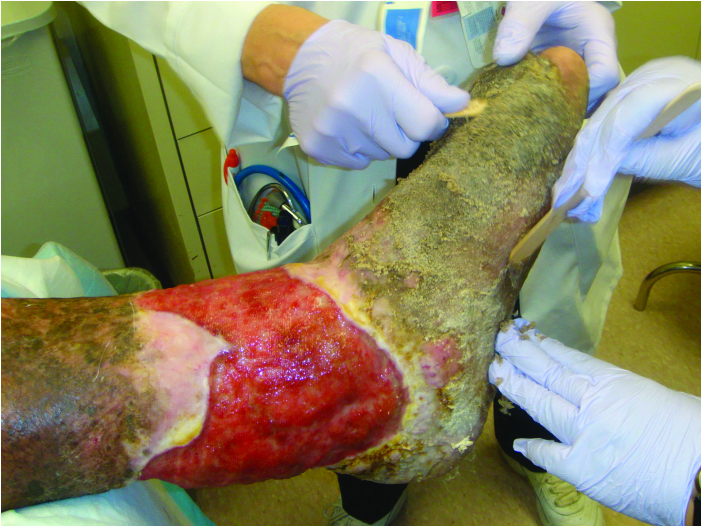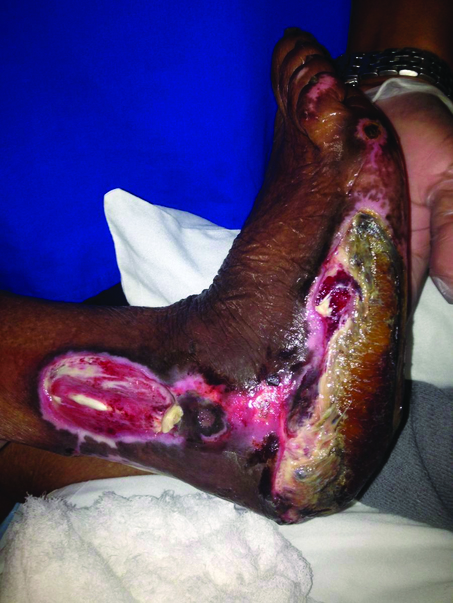ADVERTISEMENT
Current Insights On Palliative Wound Care
These expert panelists offer keys to pain management, discuss current guidelines and share their thoughts on palliative care treatment for patients at the end of their lives.
Q:
What is your standard of care for palliative wound care?
A:
 James McGuire, DPM, cites several goals for palliative care based on two articles published online in the Wound Care Advisor.1,2 He clarifies that the physician is altering the timing of the objectives and wound healing is not a goal. That said, Dr. McGuire emphasizes that one should not give up on wound healing, noting that 50 percent of palliative care wounds eventually close. Dr. McGuire notes palliative care requires a team and one should manage the patient in concert with other healthcare providers.
James McGuire, DPM, cites several goals for palliative care based on two articles published online in the Wound Care Advisor.1,2 He clarifies that the physician is altering the timing of the objectives and wound healing is not a goal. That said, Dr. McGuire emphasizes that one should not give up on wound healing, noting that 50 percent of palliative care wounds eventually close. Dr. McGuire notes palliative care requires a team and one should manage the patient in concert with other healthcare providers.
David Swain, DPM, CWS, cites a standard of care for palliative care established by the Centers for Medicare and Medicaid Services, consisting of administering care that will optimize the patient’s quality of life by anticipating, preventing and treating suffering.3
“As physicians, we should address the physical, intellectual, emotional, social and spiritual needs, and facilitate patient autonomy, access to information and choice,” notes Dr. Swain.
Dr. Swain adds that the Center to Advance Palliative Care also states that palliative treatment should focus on providing relief from the symptoms, pain and stress of any serious illness with the goal being the improvement of the quality of life for both the patient and patient’s family.4 He says the center believes this is appropriate at any age and stage of a serious illness, and one can provide this alongside curative treatment.
Kazu Suzuki, DPM, CWS, determines a standard of palliative care on a case-by-case basis. Having said that, his “palliative wound care” may not differ much from “curative wound care” in practice, saying the only difference is the treatment goal: curative versus palliative.
Dr. Suzuki says the key is communication. First, he says the clinician needs to communicate with the patient (who may be at the end of life and may not be able to communicate) and the family members, and then determine the goal of care. He says this is either curative (which is often surgical and more invasive) versus palliative care (with minimal surgical debridement if any).
Next, Dr. Suzuki says one should communicate with the patient’s primary MD as well as other healthcare professionals involved in medical decision-making. For example, if an end-of-life patient has a toe with dry gangrene and the patient elected for palliative care, he notes you may not need an urgent angiogram and magnetic resonance image.
“Palliative wound care shifts the goals from wound healing to maximizing comfort and function for the patient and family,” says Dr. McGuire.
Q:
What guidelines do you adhere to for palliative wound care?
A:
While Dr. Suzuki does not have a particular guideline, he does work closely with the “comfort care” consultation service in his institution that handles palliative care patient education and placement. In most medical settings, he says one would prescribe hospice or palliative care for a patient who has six months (or less) of his or her expected lifespan left. For example, Dr. Suzuki says the Inter-Society Consensus for the Management of Peripheral Arterial Disease (PAD) guideline recommends angioplasty for patients with PAD expected to live six months or less since angioplasty is less invasive than leg bypass procedures.5 He emphasizes that determining this expected lifespan may be difficult and imprecise in many cases, and he has known a few patients who outlived their predetermined 90 days of “remaining time” in hospice.
Dr. McGuire says there are no specific palliative care guidelines for managing lower extremity wounds, specifically foot and ankle wounds. However, he does cite a white paper from the National Pressure Ulcer Advisory Panel.6 As with most guidelines, he says the focus is on pressure injury wounds but the principles are generally the same in the foot and ankle. He also cites two other guidelines by the International Expert Wound Care Advisory Panel and the International Palliative Wound Care Initiative.7,8
Q:
What are the most effective palliative treatments for wounds?
A:
You can reduce the amount of dressing changes when using dressings that hold a maximum amount of fluid, notes Dr. McGuire. He says composite dressings are ideal for this and prevent strikethrough or drainage of fluid around the dressings from a loss of holding capacity. He notes clinicians should always use skin protectants to prevent maceration and periwound breakdown. Dr. McGuire says proper offloading also helps prevent dressing irritation and disruption. As he notes, drying the wound is normally contraindicated due to the development of a scab during wound healing but in palliative care, a dry wound may be a desired result. In regard to managing bleeding, Dr. McGuire says absorptive dressings and the use of collagens will help. He says one can use cauterization if necessary.
Dr. Suzuki and Dr. McGuire advise working with the primary care team to minimize pain. As Dr. McGuire says, the focus is on reducing the painful stimuli on the wound through protective dressings and offloading strategies. He suggests choosing dressings to minimize the number of changes and provide for atraumatic removal.
 Dr. Suzuki will provide all patients OTC acetaminophen for baseline analgesia and may add gabapentin (Neurontin, Pfizer), saying this medication has a wide safety margin and is helpful in pain management. He may add narcotic pain medication as needed, both in short-acting form for breakthrough pain and a long-acting form for more severe conditions, such as critical limb ischemia and rest pain. Dr. Suzuki has also started to prescribe edible medical marijuana, which some of his wound patients say is helpful in pain control and for facilitating better sleep.
Dr. Suzuki will provide all patients OTC acetaminophen for baseline analgesia and may add gabapentin (Neurontin, Pfizer), saying this medication has a wide safety margin and is helpful in pain management. He may add narcotic pain medication as needed, both in short-acting form for breakthrough pain and a long-acting form for more severe conditions, such as critical limb ischemia and rest pain. Dr. Suzuki has also started to prescribe edible medical marijuana, which some of his wound patients say is helpful in pain control and for facilitating better sleep.
For wounds that are very painful, Dr. Swain will utilize various nonstick dressings including a flexible polyamide net coated with silicone or a medical gauze infused with petrolatum and 3% bismuth tribromophenate (Xeroform) with secondary dressings as needed for drainage and odor. He notes topical lavage with lidocaine gel will also give temporary pain relief and help with dressing changes.
For dry gangrenous wounds, Dr. Suzuki often uses a gauze soaked in a betadine solution. Although one should not use betadine in a healing wound, he believes it is useful in temporizing the wound by reducing the bacterial load on the wound surface. For other type of wounds, he may perform surgical debridement but he tries to use debridement conservatively to minimize pain. For arterial ulcers in patients with non-treatable PAD and/or gangrene, Dr. Swain prefers cadexomer iodine gel, which keeps the ulcer stable and helps prevent infection. If there is a gangrenous toe that is stable, he will paint the wound with betadine daily until auto-amputation occurs.
In addition, Dr. Suzuki may rely on topical medication to facilitate debridement in between the office visits, citing the use of PluroGel (Medline) and Santyl (Smith & Nephew). He adds that one may use a hydrogel with antimicrobial property (Puracyn Gel, Innovacyn) to control the odor. Lastly, Dr. Suzuki notes metronidazole is an antimicrobial agent specific for anaerobic microbes responsible for offensive wound odor. He says one could add this agent as prescription metronidazole gel, a prescription compounding cream or a crushed generic metronidazole pill as cost-effective solution to control odor.
The best way to avoid wound odor, notes Dr. McGuire, is to prevent bacterial biofilm development on the wound bed. To that end, he advocates regular cleansing and dressings that contain antiseptic solutions such as hypochlorous acid, povidone or cadexomer iodine, iodine impregnated foams, pigment dressings that contain gentian violet, or silver dressings. Occasional wound debridement may also be needed but Dr. McGuire says gentle methods using autolytic debridement or enzymatic therapy are preferable. He suggests using antibiotics for infection only when consistent with patient goals and when necessary to maintain patient homeostasis. For wounds with odor, Dr. Swain will use Dakin’s solution soaked into a hydrofiber dressing and/or charcoal dressings.
For draining wounds, Dr. Swain utilizes barrier creams at the edges and absorbent dressings (alginates, hydrofiber, foams) for the drainage. For better offloading in the immobile patient with pressure ulcers, Dr. Swain will recommend a specialty mattress. He also uses foam dressing, felt offloading pads and heel protectors when appropriate.
When improving the cosmetic wound appearance, Dr. McGuire says one should try to apply dressings and offloading devices that are as attractive as possible, and help maintain a patient’s sense of dignity and need for socialization.
Dr. McGuire is a Clinical Professor in the Departments of Podiatric Medicine and Podiatric Biomechanics at the Temple University School of Podiatric Medicine. He is the Director of the Leonard S. Abrams Center for Advanced Wound Healing in Philadelphia.
Dr. Suzuki is the Medical Director of the Tower Wound Care Centers at the Cedars-Sinai Medical Towers. He is also on the medical staff of the Cedars-Sinai Medical Center in Los Angeles and is a Visiting Professor at the Tokyo Medical and Dental University in Tokyo. He can be reached at Kazu.Suzuki@cshs.org.
Dr. Swain is a board-certified wound specialist physician (CWSP) of the American Board of Wound Management, and a Diplomate of the American Board of Podiatric Medicine. He is the Medical Director of the St. Vincent’s Wound Care and Hyperbaric Center at St. Vincent’s Southside Hospital, and is in private practice in Jacksonville, Fla.
References
- Herbert GR. Palliative wound care: Part 1. Wound Care Advisor. Available at https://woundcareadvisor.com/palliative-wound-care-part-vol4-no1/ . 2015;4(1).
- Herbert GR. Palliative wound care: Part 2. Wound Care Advisor. Available at https://woundcareadvisor.com/palliative-wound-care-part-2/ . 2015:4(2).
- Centers for Medicare and Medicaid Services. Hospice and palliative care. Available at https://www.cms.gov/Outreach-and-
- Education/American-Indian-Alaska-Native/AIAN/LTSS-TA-Center/ltss-focus-areas/hospice-and-palliative-care.html . Published July 19, 2017.
- Center to Advance Palliative Care. Available at https://www.capc.org/ .
- Norgren L, Hiatt WR, Dormandy MR, et al. Inter-Society Consensus for the Management of Peripheral Arterial Disease (TASC II). J Vasc Surg. 2007; 45(Suppl 1):S5–S67.
- Langemo DK, Black J; National Pressure Ulcer Advisory Panel. Pressure ulcers in individuals receiving palliative care: a National Pressure Ulcer Advisory Panel white paper. Adv Skin Wound Care. 2010; 23(2):59–72.
- Armstrong DG, Ayello EA, Capitulo KL, et al. New opportunities to improve pressure ulcer prevention and treatment: implications of the CMS inpatient hospital care present on admission indicators/hospital-acquired conditions policy: a consensus paper from the International Expert Wound Care Advisory Panel. Adv Skin Wound Care. 2008; 21(10):469–78.
- Ferris FD, Al Khateib AA, Fromantin I, et al. Palliative wound care: managing chronic wounds across life’s continuum: a consensus statement from the International Palliative Wound Care Initiative. J Palliat Med. 2007; 10(1):37–9.











